 Last additions - GIFU 岐阜県 Last additions - GIFU 岐阜県 |

Banners mark the site where the battle started.Jan 16, 2007
|
|

Banner with Ukita Hideie's crest.Jan 16, 2007
|
|

Monument marking the site where the Sekigahara battle started at 8 am on Sept. 15, 1600 (Oct. 21 Western calendar) with Ii Naomasa firing upon Ukita Hideie.Jan 16, 2007
|
|

Path to the Kaisenchi or site where the battle started, at the foot of the hill straight ahead. 開戦地Jan 16, 2007
|
|

The battle started at the foot of the hill on the left of the road. The small hill on the right was where Shimazu Yoshihiro was stationed. Mt. Ibuki is in the background in the middle.Jan 16, 2007
|
|

Tamakurabe Clear SpringJan 07, 2007
|
|

Tamakurabe Clear Spring 日本武尊ゆかりの泉「玉倉部の清水」Jan 07, 2007
|
|

Cavern exitJan 07, 2007
|
|

Tamakurabe Clear Spring was where Yamato Takeru-no-Mikoto got cured by drinking the water after encountering poison mist on Mt. Ibuki.Jan 07, 2007
|
|
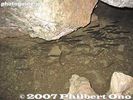
Rainbow trout in the clear (and cold) spring waters.Jan 07, 2007
|
|

Jan 07, 2007
|
|
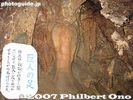
Giant's Leg 巨人の足Jan 07, 2007
|
|
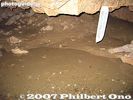
Jan 07, 2007
|
|

Jan 07, 2007
|
|
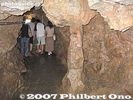
Height of the cavern is barely enough for an adult to walk througgh.Jan 07, 2007
|
|

The cavern is 518 meters long, taking 20 min. to walk it.Jan 07, 2007
|
|

Paleozoic fossilJan 07, 2007
|
|

There are no stairs so you can even take a baby stroller.Jan 07, 2007
|
|

Entrance to cavern.Jan 07, 2007
|
|

Sekigahara Stalactite Cavern parking lot. The blue-roof building is a souvenir shop and restaurant.Jan 07, 2007
|
|
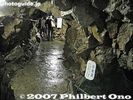
Inside cavern.Jan 07, 2007
|
|

Memorial for the fallen warriors at the Battle of Sekigahara, built in 2000, the 400th anniversary.Jan 06, 2007
|
|

Jan 06, 2007
|
|

Tokugawa allies at his base campJan 06, 2007
|
|

Evidence of victoryJan 06, 2007
|
|

Memorial for the fallen warriors at the Battle of SekigaharaJan 06, 2007
|
|

Ishida Mitsunari on Mt. SasaoyamaJan 06, 2007
|
|

Sekigahara WarlandJan 06, 2007
|
|

Heads of the enemyJan 06, 2007
|
|

Tokugawa Ieyasu inspecting the head of his enemies at his base campJan 06, 2007
|
|

Tokugawa Ieyasu at his base campJan 06, 2007
|
|

Jan 06, 2007
|
|

Jan 06, 2007
|
|

Ishida Mitsunari on Mt. SasaoyamaJan 06, 2007
|
|

Hand-to-hand combatJan 06, 2007
|
|

Jan 06, 2007
|
|

Kobayakawa Hideaki on Mt. Matsuo who turned against Ishida Mitsunari and helped Ieyasu win the battle.Jan 06, 2007
|
|

Battle Museum 合戦資料館Jan 06, 2007
|
|

Jan 06, 2007
|
|

Jan 06, 2007
|
|

Yamauchi KazutoyoJan 06, 2007
|
|

Entrance to Sekigahara WarlandJan 06, 2007
|
|

Matchlock gunsJan 06, 2007
|
|

Jan 06, 2007
|
|

Warland pathJan 06, 2007
|
|

Inside museum with a map of the battleJan 06, 2007
|
|

Battle of Sekigahara signboard at Sekigahara Station, Western ForcesJan 06, 2007
|
|

Battle of Sekigahara signboard at Sekigahara StationJan 06, 2007
|
|

JR Sekigahara Station platformJan 06, 2007
|
|

Battle of Sekigahara signboard at Sekigahara StationJan 06, 2007
|
|

Battle of Sekigahara signboard at Sekigahara Station, Eastern ForcesJan 06, 2007
|
|

JR Sekigahara Station platformJan 06, 2007
|
|

Weapons used in battleJan 06, 2007
|
|

Warlord banners, left to right: Kuroda, Fukushima, Honda, and Tokugawa.Jan 06, 2007
|
|

Jan 06, 2007
|
|

Profiles of Western ForcesJan 06, 2007
|
|

Inside Sekigahara Town History and Folklore Museum 関ヶ原町歴史民俗資料館Jan 06, 2007
|
|

Illustration of Mt. Matsuo where Lord Kobayakawa Hideaki was based.Jan 06, 2007
|
|

Samurai armor with matchlock gun bullet holes.Created by an experiment with matchlock gun fired at the body armor at over 50 meters aways, piercing both the front and back body armor.Jan 06, 2007
|
|

Sekigahara Town History and Folklore Museum 関ヶ原町歴史民俗資料館Jan 06, 2007
|
|

2nd floorJan 06, 2007
|
|

Conch shell for battle.Jan 06, 2007
|
|

Marker for Tokugawa Ieyasu's Final Base CampJan 06, 2007
|
|

Warlord bannersJan 06, 2007
|
|

Profiles of neutral armiesJan 06, 2007
|
|

Explanatory map of the Battle of SekigaharaJan 06, 2007
|
|

Ishida Mitsunari, age 41 at the time of the battleJan 06, 2007
|
|

Tokugawa Ieyasu's Final Base Camp at Jinbano. At 10 am, he moved here from Mt. Momokubari to be closer to the front line. 陣場野 徳川家康最後陣跡Jan 06, 2007
|
|

CannonJan 06, 2007
|
|

Marker for Tokugawa Ieyasu's Final Base CampJan 06, 2007
|
|
|

Statue of Lord Takenaka Hanbei 竹中半兵衛重治Jan 06, 2007
|
|

Unique helmets worn by warlords on the battlefield.Jan 06, 2007
|
|

Illustration of Tokugawa Ieyasu's Final Base Camp where he inspected the heads of his defeated enemies.Jan 06, 2007
|
|

Explanatory map of the Battle of SekigaharaJan 06, 2007
|
|

Battlefield as seen from the final battle site. Thousands died here. The battlefield is a small plain surrounded by hills and mountains.Jan 06, 2007
|
|

Sekigahara Town History and Folklore Museum 関ヶ原町歴史民俗資料館Near Tokugawa Ieyasu's Final Base Camp.Jan 06, 2007
|
|

Lookout deck with a bird's eye view of the battlefield.Jan 06, 2007
|
|

Marker for Tokugawa Ieyasu's Final Base CampJan 06, 2007
|
|

Tokugawa Ieyasu's Final Base Camp at Jinbano 陣場野 徳川家康最後陣跡Jan 06, 2007
|
|

Inside Tokugawa Ieyasu's Final Base CampJan 06, 2007
|
|

Monument for the final battle. By 1 pm, Ishida's Western Forces fell apart, and Ishida fled the scene at 2 pm. 決戦地Jan 06, 2007
|
|

Tokugawa Ieyasu's Final Base Camp at Jinbano 陣場野 徳川家康最後陣跡Jan 06, 2007
|
|

Mt. Sasaoyama and stone monument marking Ishida Mitsunari's base camp.Jan 06, 2007
|
|

Sekigahara Battlefield and Mt. Matsuo 関ヶ原古戦場Jan 06, 2007
|
|

Monument for the final battle, about 1 km in front of Mt. Sasaoyama, where the fighting was the fiercest. 決戦地The left banner has the Ishida Mitsunari's crest and the right banner has the Tokugawa crest.Jan 06, 2007
|
|

Map on lookout deck.Jan 06, 2007
|
|

Sekigahara Battlefield, now occupied mainly by rice paddies, a school, and homes. 関ヶ原古戦場Jan 06, 2007
|
|

Steps up to the top of Mt. Sasaoyama.Jan 06, 2007
|
|

Top of Mt. Sasaoyama and stone monumentJan 06, 2007
|
|

Mt. Sasaoyama and stone monument marking Ishida Mitsunari's base camp.Jan 06, 2007
|
|

Jan 06, 2007
|
|

Top of Mt. SasaoyamaJan 06, 2007
|
|

Mt. Sasaoyama and stone marker. 笹尾山Jan 06, 2007
|
|

Barriers and steps looking down the slope.Jan 06, 2007
|
|

Lookout deck on Mt. Sasao. 笹尾山Jan 06, 2007
|
|

Jan 06, 2007
|
|

Jan 06, 2007
|
|

Jan 06, 2007
|
|

Ishida Mitsunari's banner with his family crest.Jan 06, 2007
|
|

Foot of Mt. Sasaoyama, Ishida Mitsunari's base camp. 笹尾山 石田三成陣跡Jan 06, 2007
|
|

Defensive barriers on Mt. Sasaoyama, Ishida Mitsunari's base camp. 笹尾山 石田三成陣跡Jan 06, 2007
|
|

Foot of Mt. Sasao, Ishida Mitsunari's base camp. 笹尾山 石田三成陣跡Jan 06, 2007
|
|

Mt. Sasaoyama, Ishida Mitsunari's base camp, as seen from the final battlefield. 笹尾山Jan 06, 2007
|
|
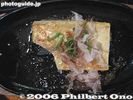
Tofu steakNov 13, 2006
|
|
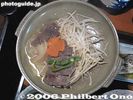
Hida beefNov 13, 2006
|
|

Inside OtayaNov 13, 2006
|
|
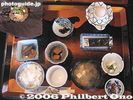
Breakfast at OtayaNov 13, 2006
|
|
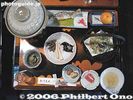
DinnerNov 13, 2006
|
|

Due to a lack of thatch, only half of one side of Otaya's roof is newly thatched.Nov 13, 2006
|
|
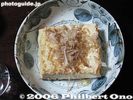
TofuNov 13, 2006
|
|

Otaya minshuku 民宿 太田屋Nov 13, 2006
|
|
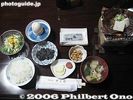
Breakfast at Isaburo minshukuNov 13, 2006
|
|
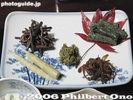
Mountain vegetables 山菜Nov 13, 2006
|
|
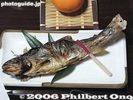
Grilled Iwana river fishNov 13, 2006
|
|
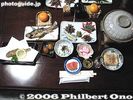
Dinner at Isaburo: River fish and mountain vegetables. After dinner, the proprietress and her husband and daughter sang and danced for us. They demonstrated different traditional musical instruments and had us try playing them. It was great. However, I was told that they don't do that anymore.Nov 13, 2006
|
|
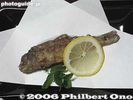
Fried Iwana, eat the head and all.Nov 13, 2006
|
|

Isaburo minshuku 民宿 伊三郎Nov 13, 2006
|
|

Entrance to IsaburoNov 13, 2006
|
|

River next to the inn, mainly to carry away snow.Nov 13, 2006
|
|

Nov 13, 2006
|
|

View of temple roofNov 13, 2006
|
|

Nov 13, 2006
|
|

Myozenji Temple MuseumNov 13, 2006
|
|

Myozenji Temple, Shirakawa-goNov 13, 2006
|
|
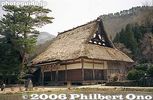
Nov 13, 2006
|
|
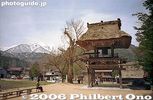
Nov 13, 2006
|
|

Myozenji temple bell with thatched roofNov 13, 2006
|
|

Nov 13, 2006
|
|

Myozenji is a Buddhist temple of the Jodo Shinshu sect, the most common sect in Shirakawa-go.Nov 13, 2006
|
|

Myozenji is the only temple in the gassho-zukuri style with a thatched roof. The Hondo worshp hall is the largest building in Shirakawa-go.Nov 13, 2006
|
|
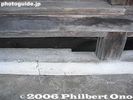
Two foundation beams interlock.Nov 13, 2006
|
|
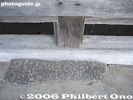
Foundation and pillars rest on stones. The beam is shaped to fit the stone.Nov 13, 2006
|
|
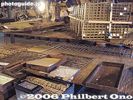
Implements to raise silkworms.Nov 13, 2006
|
|
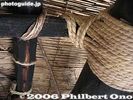
Another rope made of a crushed tree branch to tie smaller beams. It tightens as it dries.Nov 13, 2006
|
|
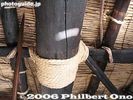
Nov 13, 2006
|
|

Straw rope tie the large beams to form a truss for the roof.Nov 13, 2006
|
|

Where silkworms were raised to make silk cocoons.Nov 13, 2006
|
|
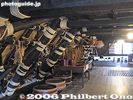
The bottom ends of these beams are pegged into a point (komajiri) resting on another cross beam. Wada House, Shirakawa-goNov 13, 2006
|
|

Slats on the attic floor to enable smoke and soot from the hearth to reach the attic.Nov 13, 2006
|
|
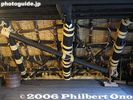
Underside of roof made of an A-frame truss structureNov 13, 2006
|
|

Nov 13, 2006
|
|

A small stream beside the house helps to melt the snow falling off the roof.Nov 13, 2006
|
|

Wada House, Shirakawa-goNov 13, 2006
|
|

Gable openings let light and air come through the attic to foster silkworms.Nov 13, 2006
|
|

Path to Wada House entranceNov 13, 2006
|
|

Main house on left and latrine on right with large vats to gather fertilizer.Nov 13, 2006
|
|

Side view of Wada-ke HouseNov 13, 2006
|
|

Main house with a recently rethatched roof, making it look very smooth.Nov 13, 2006
|
|
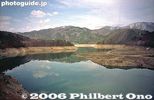
Dam reservoirNov 13, 2006
|
|

Shirakawa Village OfficeNov 13, 2006
|
|

Nov 13, 2006
|
|

Manhole in Shirakawa-go.Nov 13, 2006
|
|

Fire hydrantNov 13, 2006
|
|

Nov 13, 2006
|
|
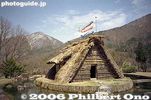
Gassho-zukuri Minka-en outdoor museumNov 13, 2006
|
|
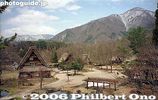
Gassho-zukuri minka houses slated for destruction were moved to this outdoor museum and saved.Nov 13, 2006
|
|

Mihoro Dam, made only of rocks and clay. 131 meters high, 405 meters long.Nov 13, 2006
|
|
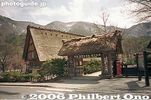
Entrance to the Gassho-zukuri Minka-en outdoor museum.Nov 13, 2006
|
|
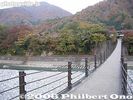
Nov 13, 2006
|
|

Deai BridgeNov 13, 2006
|
|
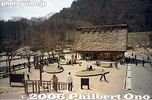
Tourist Info Office near the bus stop.Nov 13, 2006
|
|
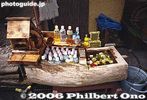
Cooling systemNov 13, 2006
|
|

Deai Bridge crossing the Shokawa River.Nov 13, 2006
|
|

Gassho-zukuri Minka-en outdoor museumNov 13, 2006
|
|
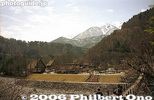
Nov 13, 2006
|
|

Shokawa RiverNov 13, 2006
|
|

Nov 13, 2006
|
|
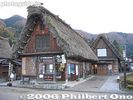
Tourist Information OfficeNov 13, 2006
|
|
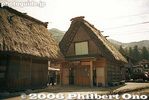
Restroom behind the Tourist Information OfficeNov 13, 2006
|
|

Parking lot along the main road through the village.Nov 13, 2006
|
|
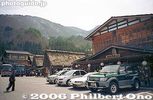
Tourist Information Office in the center of town.Nov 13, 2006
|
|
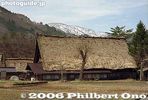
Nov 13, 2006
|
|
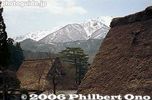
Nov 13, 2006
|
|

Nov 13, 2006
|
|
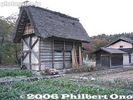
Nov 13, 2006
|
|

Nov 13, 2006
|
|
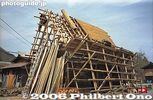
Rethatching a small storehouse.Nov 13, 2006
|
|

Thatch repair work.Nov 13, 2006
|
|
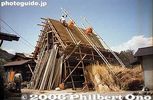
Nov 13, 2006
|
|
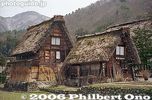
Nov 13, 2006
|
|
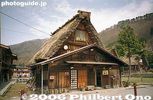
Photo galleryNov 13, 2006
|
|

RestaurantNov 13, 2006
|
|
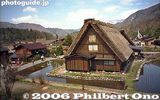
Shirakawa-go 白川郷Nov 13, 2006
|
|

Nov 13, 2006
|
|

It costs several million yen and a small army of workers to replace the thatch. The cost is subsidized by the town, prefecture, and national government.Nov 13, 2006
|
|

Nov 13, 2006
|
|

The thatched roof is replaced every 30 years. Every spring, 6 or 7 thatched roofs are replaced in Shirakawa-go.Nov 13, 2006
|
|

Nov 13, 2006
|
|

Nov 13, 2006
|
|

Shirakawa-go 白川郷Nov 13, 2006
|
|

Nov 13, 2006
|
|

Nov 13, 2006
|
|

Close-up of OgimachiNov 13, 2006
|
|

Bird's eye view of Shirakawa-go from Ogimachi Castle ruins.Nov 13, 2006
|
|

Shirakawa-go is also a National Important Traditional Townscape Preservation District (重要伝統的建造物群保存地区).Nov 13, 2006
|
|

Another observation deckJul 24, 2005
|
|

Ropeway stationJul 24, 2005
|
|
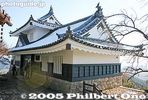
Gifu Castle MuseumIt is located on the site of a storehouse.Jul 24, 2005
|
|
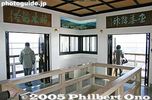
Top floor of castle towerJul 24, 2005
|
|
|
|

Castle tower observation deckMarvelous views of Gifu city can be had.Jul 24, 2005
|
|

Inside Gifu Castle MuseumJul 24, 2005
|
|

Castle tower baseJul 24, 2005
|
|

Inside the castle towerIt is a museum inside the tower.Jul 24, 2005
|
|

Castle clockJul 24, 2005
|
|

Low-angle view of castle towerJul 24, 2005
|
|
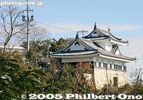
Gifu Castle MuseumJul 24, 2005
|
|

Castle towerJul 24, 2005
|
|

Path to Gifu Castle towerJul 24, 2005
|
|

Gifu Castle towerGifu Castle was originally called Inabayama Castle. Its known history starts from the 16th century with Lord Saito Dosan. Oda Nodunaga later took over the castle in 1567. He also renamed Inaba city as "Gifu."
Nobunaga left Gifu Castle and moved to Azuchi Castle in Shiga Pref. His sons took over Gifu Castle. Right before the Battle of Sekigahara, Tokygawa Ieyasu's forces attacked Gifu Castle which burned to the ground on Aug. 23, 1600.
The current castle tower was reconstructed in 1954.Jul 24, 2005
|
|

Former horseback riding groundsJul 24, 2005
|
|

Path to the castle towerGo up the left steps to proceed to the tower.Jul 24, 2005
|
|

Remains of the Ninomaru-mon GateJul 24, 2005
|
|

Tenka Daiichi-no-mon GateThe first gate toward the castle tower.Jul 24, 2005
|
|

Gifu Castle on Mt. Kinkazan as seen from the Tokaido Line train. The castle can still be seen from many kilometers away. It is one of the symbols of Gifu city.Jul 24, 2005
|
|

Gifu Castle ropeway boarding areaJul 24, 2005
|
|

Gifu Castle on Mt. Kinkazan and ropewayA convenient ropeway makes it a snap to visit the castle.Jul 24, 2005
|
|
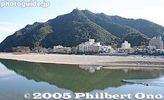
Gifu Castle on Mt. Kinkazan as seen from the Nagara River. In the foreground is Nagaragawa Onsen Spa. Commanding a strategic viewpoint of the entire city, Mt. Kinkazan must have looked like an obvious place to build a castle.Jul 24, 2005
|
|
|
| 2991 files on 12 page(s) |
 |
 |
 |
 |
12 |
|